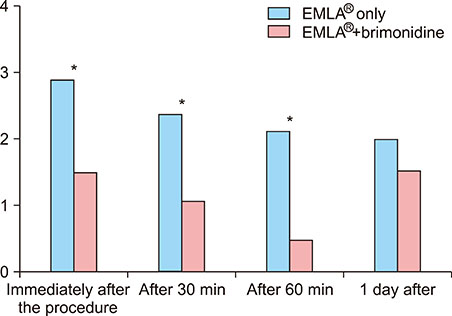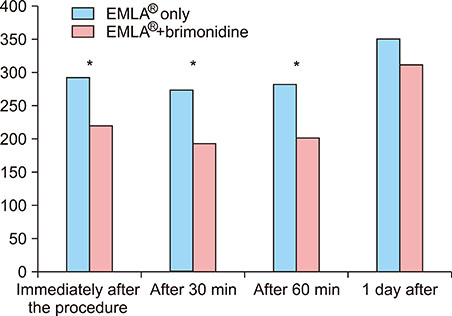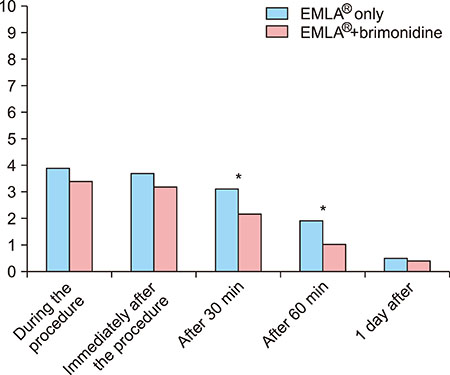Ann Dermatol.
2019 Jun;31(3):315-319. 10.5021/ad.2019.31.3.315.
Topical Brimonidine as an Effective Adjuvant to Local Anesthetics for Post Treatment Erythema and Pain Reduction
- Affiliations
-
- 1Department of Dermatology, Chung-Ang University College of Medicine, Seoul, Korea. momo920@hanmail.net
- 2Yonsei Star Skin & Laser Clinic, Seoul, Korea.
- 3Louis Dermatologic Clinic, Guri, Korea.
- KMID: 2444864
- DOI: http://doi.org/10.5021/ad.2019.31.3.315
Abstract
- BACKGROUND
There are few pharmacologic options to reduce laser-associated post treatment erythema and to extend topical anesthesia duration. To improve the tolerability of painful laser treatment, dermatologists should encourage development of a novel adjuvant agent to topical lidocaine cream.
OBJECTIVE
To report the efficacy and safety of a combination of topical brimonidine and anesthetic cream as an aid for post treatment erythema and pain.
METHODS
A total of 15 Korean subjects were randomized to receive a split-face application of a mixture of brimonidine and anesthetics on one side and only anesthetics on the other side of the face for anesthesia. After non-ablative fractional full-face skin resurfacing, Clinician's Erythema Assessment, erythema index, and visual analogue scale were assessed at four time points: immediately after resurfacing, 30 minutes after, 60 minutes after, and 1 day after.
RESULTS
A combination of brimonidine and anesthetics significantly lowered post treatment erythema until 60 minutes after the laser procedure. Furthermore, patients reported significantly lower post-procedural pain from the side of their face that received the mixture of anesthetics and brimonidine than they did for the side that only received anesthetics.
CONCLUSION
Topical brimonidine can be used as an effective adjuvant agent to lidocaine-based topical anesthetics.
Keyword
MeSH Terms
Figure
Reference
-
1. Friedman PM, Mafong EA, Friedman ES, Geronemus RG. Topical anesthetics update: EMLA and beyond. Dermatol Surg. 2001; 27:1019–1026.
Article2. Huang W, Vidimos A. Topical anesthetics in dermatology. J Am Acad Dermatol. 2000; 43:286–298.
Article3. Jussi L, Lammintausta K. Sources of sensitization, cross-reactions, and occupational sensitization to topical anaesthetics among general dermatology patients. Contact Dermatitis. 2009; 60:150–154.
Article4. ECC Committee, Subcommittees and Task Forces of the American Heart Association. 2005 American Heart Association guidelines for cardiopulmonary resuscitation and emergency cardiovascular care. Circulation. 2005; 112:24 Suppl. IV1–IV203.5. Ohlsén L, Englesson S, Evers H. An anaesthetic lidocaine/prilocaine cream (EMLA) for epicutaneous application tested for cutting split skin grafts. Scand J Plast Reconstr Surg. 1985; 19:201–209.
Article6. Layton AM, Schaller M, Homey B, Hofmann MA, Bewley AP, Lehmann P, et al. Brimonidine gel 0.33% rapidly improves patient-reported outcomes by controlling facial erythema of rosacea: a randomized, double-blind, vehicle-controlled study. J Eur Acad Dermatol Venereol. 2015; 29:2405–2410.
Article7. Gerber PA. Topical brimonidine tartrate 0·33% gel effectively reduces the post-treatment erythema of daylight-activated photodynamic therapy. Br J Dermatol. 2016; 174:1422–1423.
Article8. Schleichert R, Weiss E. Topical brimonidine gel as a hemostatic agent after dermatologic surgery. Dermatol Surg. 2015; 41:872–873.
Article9. Liu S, Carpenter RL, Chiu AA, McGill TJ, Mantell SA. Epinephrine prolongs duration of subcutaneous infiltration of local anesthesia in a dose-related manner. Correlation with magnitude of vasoconstriction. Reg Anesth. 1995; 20:378–384.10. Carvalho Froes G, de Assis Ottoni F, Gontijo G. Topical anesthetics. Surg Cosmet Dermatol. 2010; 2:111–116.11. Covino BG. Pharmacology of local anaesthetic agents. Br J Anaesth. 1986; 58:701–716.
Article12. Pöpping DM, Elia N, Marret E, Wenk M, Tramèr MR. Clonidine as an adjuvant to local anesthetics for peripheral nerve and plexus blocks: a meta-analysis of randomized trials. Anesthesiology. 2009; 111:406–415.
Article13. Kroin JS, Buvanendran A, Beck DR, Topic JE, Watts DE, Tuman KJ. Clonidine prolongation of lidocaine analgesia after sciatic nerve block in rats Is mediated via the hyperpolarization-activated cation current, not by alpha-adrenoreceptors. Anesthesiology. 2004; 101:488–494.
Article14. Eisenach JC, De Kock M, Klimscha W. Alpha(2)-adrenergic agonists for regional anesthesia. A clinical review of clonidine (1984-1995). Anesthesiology. 1996; 85:655–674.15. Kopacz DJ, Bernards CM. Effect of clonidine on lidocaine clearance in vivo: a microdialysis study in humans. Anesthesiology. 2001; 95:1371–1376.16. Burke J, Schwartz M. Preclinical evaluation of brimonidine. Surv Ophthalmol. 1996; 41:Suppl 1. S9–S18.
Article17. Braun SA, Artzi O, Gerber PA. Brimonidine tartrate 0.33% gel for the management of posttreatment erythema induced by laser skin resurfacing. J Am Acad Dermatol. 2017; 76:e53–e55.
Article18. Montague AJ, Bangh S, Cole JB. Bradycardia in a child after using brimonidine as toothpaste. JAMA Dermatol. 2017; 153:330–331.
Article19. Shagalov DR, Taylor D, Schleichert R, Weiss J, Weiss E. Association of central nervous system depression with topical brimonidine when used for hemostasis: a serious adverse event. JAMA Dermatol. 2017; 153:575–577.
Article





